
Forty years ago today, on April 5, 1975, a series called “Goranger” premiered on the TV Asahi network in Japan. The full Japanese title of the show is “Himitsu Sentai Gorenja,” translated literally into English as “Secret Squadron FiveRangers.” It was the first in a long franchise devoted to the concept of a team of five people (usually four men and one woman) in color-coded costumes that bestow certain powers and skills on them so they can work together to defeat monstrous enemies either based on Earth or from other planets (or dimensions) who attack Japan and wreak havoc on, usually, Tokyo. Sentai is the general term for this franchise, although Super Sentai is technically the more accurate term for the seasons that began in 1979 since Super Sentai refers to a sentai series with mecha (mechanical vehicles, usually human- or animal-shaped) used by the heroes. (I’m just going to refer to the entire franchise as sentai, non-italicized, in the rest of this piece.) Sentai series are best known in the U.S. for their American version, Power Rangers, which has been on the air since 1993. (The picture on top is from “Denjiman,” the 1980 sentai season, which I’ve reviewed here on IMDB.)

Sentai shows are part of the broader Japanese genre of tokusatsu, meaning live-action special effects programs, usually in the sci-fi or fantasy genres. Famous tokusatsu programs include the Ultraman and Kamen Rider franchises and “Giant Robo” (aka “Johnny Sokko and His Flying Robot”). I covered some of these shows in Ultraman Heaven, my entry from December 15, 2014, and Classic Japanese TV from March 16, 2014.
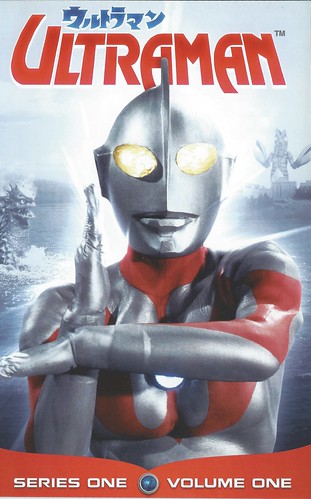
In “Twenty Years of Super Sentai,” from the fan publication, Ultra-Fan (#1, Jan. 1996) Jim Cirronella offers a concise overview of the sentai genre:
Every year, the Toei Company produces a a brand-new 50 episode serial; each half-hour installment tells its own tale while advancing the ongoing narrative to the final conclusion. The stories, characters and background mythology will change with each new series, but the basic concept always remains the same: Earth is being threatened by a malevolent force and humanity’s only hope lies with a team of warriors who attain their super-powers through fantastic metamorphosis….
Without being preachy or boring, each Sentai series underlines two fundamental principles. First, Sentai teams are usually composed of ordinary people; it is their positive spirit that sets them apart. Anyone from any walk of life can be a hero. Second, although each warrior possesses special powers, everyone is considered equal. In the end, it is teamwork that saves the day. (Also prevalent in these programs is the strong student-teacher relationship between the warriors and their mentor/team commander.)
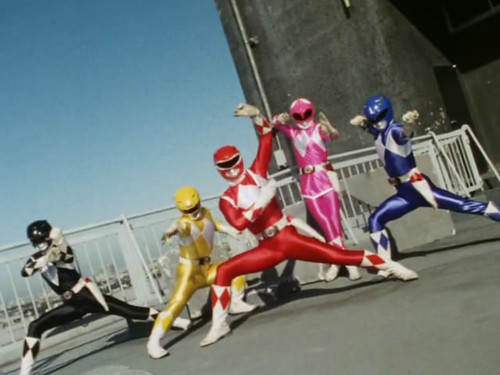
When the first Power Rangers series, “Mighty Morphin Power Rangers,” premiered in the U.S. on August 28, 1993 it struck an immediate chord with even the most nascent fans of Japanese pop culture, thanks to its use of special effects and action footage taken from the 1992 sentai series, “Kyoryu Sentai Zyuranger.” Every time the protagonists, a multiracial group of friends at Angel Grove High School in California, transformed into the Power Rangers, the show immediately shifted into footage from “Zyuranger.”


When I first heard about the show that fall, I immediately investigated and determined right away that the show had to have Japanese origins. I soon learned from my anime dealer at local monthly comics shows (pre-internet) exactly which show “Mighty Morphin” was based on and quickly acquired a tape containing the first four episodes of “Zyuranger” in Japanese with no subtitles. I showed it to my then-ten-year-old daughter and two of her friends who lived down the hall from us, all of whom had seen “Power Rangers” already. One of the friends, nine-year-old Marcos, was stunned. “My friends aren’t gonna believe me when I tell them I saw this,” he kept muttering. So the next time I saw him, I asked if his friends believed him. No they hadn’t, except for one girl who’d noticed that the Yellow Ranger, in the action footage, didn’t have a skirt on her costume like the Pink Ranger which, to this perceptive young girl, supported Marcos’ assertion that the Yellow Ranger in the original was male! I wound up showing the tape to numerous other young people in my extended family and the general consensus was puzzlement as to why they didn’t just dub the original show into English and run it as is. The original was much more serious and action-packed than the U.S. version and had nothing like the high school slapstick and comic antics associated with Angel Grove High School.
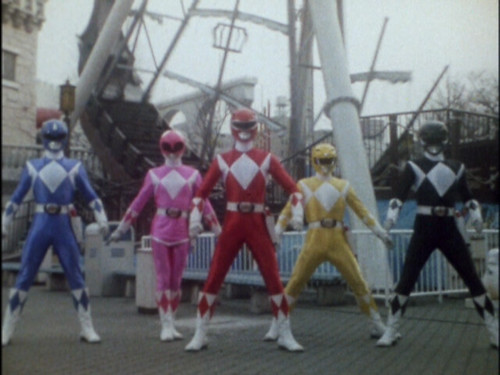

I wound up doing a paper for a Cinema Studies graduate school course at New York University on how Japanese pop culture had to be altered and transformed to make it acceptable to an American audience, using “Street Fighter II” and “Power Rangers” as case studies. I presented the paper at a student cinema studies conference on a Saturday morning in 1996 and included the following paragraph, which got a big laugh with the last line:
A look at the original Japanese show reveals some of what gets lost in the re-edit. The Japanese teens of “Zyurangers” are all ancient warriors newly brought back to life after thousands of years by their aged sorcerer mentor in response to a new threat to earth from the ancient witch Bandora who had been inadvertently freed from her prison on the moon by two unwitting space shuttle astronauts. These teens don’t attend school, but engage in martial arts and weapons training and study ancient texts for clues to their mission and the nature of the monsters they confront. Many of their fight scenes occur before they can transform into Zyuranger mode, making them ever on call, unlike their American counterparts who seem to fight only after school and before dinner.
The sentai franchise had its roots in other series. The success of Ultraman, including the creation of an English-dubbed version that was widely shown in the U.S., was, of course, the motivating force for the production of numerous tokusatsu series, including Toei’s “Giant Robo” series, which also ran in the U.S. (under the “Johnny Sokko” title). Meanwhile, manga artist Shotaro Ishinomori was experiencing success with “Cyborg 009,” a comic series that began publication in 1964 and led to two animated color films in 1966-67 and one black-and-white animated TV series in 1968. “Cyborg 009” offered a team of nine cyborg heroes, each with the same costume, but boasting a completely different power. Ishinomori went on to create a costumed superhero for live-action television, “Kamen Rider,” in 1971, a franchise that, like sentai and Ultraman, shows no signs of abating.



Also, in 1972, an animated series called “Gatchaman” introduced the concept of five young heroes (four boys, one girl) in matching costumes working as a team and employing vehicles and weapons that required all five to operate them at once. One can argue that this concept, combined with “Kamen Rider,” is what led to the first sentai series, “Goranger,” which was also created by Shotaro Ishinomori.


The five members of Goranger (1975-77)

I tend to be most familiar with the sentai series that began with “Zyuranger” (1992) and continue on to this day, since I’ve followed the Power Rangers franchise on American television and sought out DVDs of their corresponding sentai seasons. However, all but one of the sources for those DVDs has dried up, leaving only HQ Video in Manhattan as the one Japanese video store where I can get Japanese TV shows on a regular basis, albeit in Japanese only, with no subtitles. Since sentai series are filled with action and special effects, I’ve never been too bothered by the lack of subtitles. (Of course, more and more of these series are turning up on-line in subtitled versions on YouTube, Facebook and other places.) Granted, there are English-language websites with plot synopses of these shows, including summaries of individual episodes, but they’re written by people who have no understanding of plot and character points and no ability to write useful summaries. They’re filled with details about villains’ names, powers, and weapons, and the heroes’ special powers and weapons, but nothing about goals or motivation or emotional arcs or what’s actually being said in the dialogue, so it’s pointless trying to consult them.

Like the Japanese kaiju films (Godzilla et al) produced by Toho and the various Ultraman series produced by Tsuburaya Productions, as well as Toei’s own Kamen Rider series, the sentai series boast lots of quintessentially Japanese forms of imaginative action filming, from mass martial arts battles to fast cars and cycles racing through countrysides and city streets in pursuit of bad guys to giant robots slugging it out with giant monsters amidst the Tokyo skyline. There is action aplenty in every episode as well as special effects derived chiefly from miniature sets and actors in robot and monster suits enacting large-scale brawls on those sets. I love the way these effects look when shot on film. And I love the cool vehicles the characters travel in, usually created in miniature in the studio. I much prefer this aesthetic to the CGI employed in most American special effects extravaganzas.
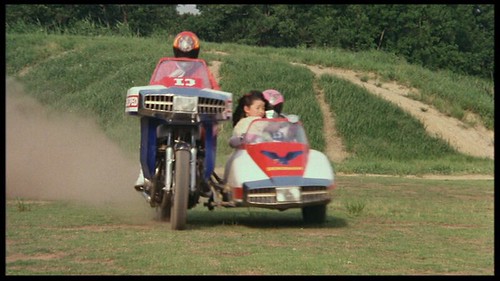

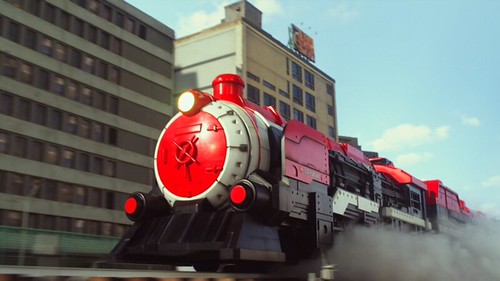





The early sentai series were notable for their intricate martial arts battles, thanks to the use of actors trained by Japan Action Club, formed by Sonny Chiba, the star of the successful martial arts movie franchise, “Street Fighter,” to provide the casts of Japanese films and TV shows with skilled martial artists. These actors were older and more intense than the young cast members of later sentai seasons. The most notable protégé of Chiba’s to appear in sentai series was Kenji Ohba, who some fans may know from his scene as Chiba’s sidekick at the sushi shop in Quentin Tarantino’s KILL BILL VOL. 1.

Kenji Ohba in KILL BILL, VOL. 1 (2003)
He was one of the team in two consecutive sentai seasons, “Battle Fever J” and “Denjiman,” before starring in his own tokusatsu series, “Space Sheriff Gavan” in 1982, also from Toei. He would later, in the 2010s, star as Gavan in crossover movies with the sentai franchise, as well as reprise his Denjiman sentai role in the all-star mash-up, GOKAIGER GOSEIGER SUPER SENTAI 199 HERO GREAT BATTLE (2011). Here we see him in two closeups as the same character filmed 30 years apart:


Ohba fans should definitely seek out “Gavan,” since he’s at his peak there, doing tons of fighting out of costume in each episode and doing all his own considerable stunts. It’s just one great burst of tokusatsu action after another in every episode.


Early sentai seasons had adult casts. Teenage (or early 20s) cast members became predominant beginning with “Zyuranger” and have tended to be the norm ever since.
1980:

1992:

2011:

In the U.S., the teens (usually played by 20-somethings) have generally been the norm also, although “Power Rangers Lightspeed Rescue” (based on the 1999 sentai season, “Go Go Five”) skewed a little older because its five team members were all rescue or emergency services personnel.
As the casts got younger, later seasons of sentai series relied more on stunt people and Hong Kong-inspired wirework so the leads weren’t doing much in the way of intricate fighting on their own. San Francisco-based writer-editor Damon Foster, one of the early champions of sentai in the U.S., once edited a magazine called Oriental Cinema that often critiqued these shows. He was a little upset with the decline of martial arts in the sentai originals and took pains to deem “Mighty Morphin Power Rangers” praiseworthy for the expert staging of the fights shot specifically for the American footage. This is from an article he wrote called “Kaizo Ningen Update” that appeared in Oriental Cinema Vol. 3 no. 4, October 1994:
As you know, I consider ‘Power Rangers’ a symbol of racism, they cut out all the Japanese actors…and spliced in footage of American airheads….But later ‘Power Rangers’ episodes gradually fizzled out most of the Japanese stock footage, once the Americans finally caught on! I must say, the American filmed fights in the later episodes are as good, if not better than the original “Zyu Rangers’ series from 1992!…This type of superb martial arts is new to American TV, complete with Wushu/kung fu stances and acrobats! They don’t have a lot of this on Japanese TV anymore, because Japanese audiences have been jaded and brainwashed over the years, as the quality of the Sentai programs gradually declined. So although I have mixed reactions to the success of ‘Power Rangers’ in the U.S., I’d say that ‘Power Rangers’ is the successor to Japan’s ‘Zyu Rangers.’ Among other things, the new American fights are taking ideas from HK [Hong Kong] action films, incorporating full contact hits and that thrilling ‘powder puff’ effect, something once utilized so heavily by Jackie Chan!
However, he neglects to point out that the key person responsible for this upgrade in Power Rangers fight scenes was the celebrated action choreographer Jeff Pruitt, also known for his work on the “Buffy, the Vampire Slayer” TV series.
Another reason I enjoy sentai series is their frequent use of Tokyo locations to stage fight scenes, including industrial and waterfront areas and railroads. They often fight in arena or stadium parking lots or waiting areas. They even use outdoor performance areas quite often. I’ve seen a lot of Japanese pop music concert DVDs filmed at these areas so it’s something quite familiar to me.







And, from a J-pop concert:

I have over 45 sentai movie spin-offs of the TV franchise and hundreds (thousands?) of sentai TV episodes, mostly from 1992 on, but with a good sprinkling of earlier season samples. I haven’t seen all of them. I don’t know how many years it will take me. There is way too much good stuff in the franchise to single out in one piece here, but here are a couple of the movie spin-offs worth highlighting.
JUKEN SENTAI GEKIRANGER: NEI-NEI! HOU-HOU! HONG KONG DECISIVE BATTLE, aka THE GEKIRANGER MOVIE (2007) took place in Hong Kong and had giant robots and monsters battling it out there. (Gekiranger was the 2007 sentai season and became “Power Rangers Jungle Fury” in the U.S.)




Its villain was played by Masashi Ishibashi, who is well known to fans of Sonny Chiba’s movies. (He played a key antagonist in Chiba’s first Street Fighter movie.) Ishibashi was 74 when he came out of retirement to make this film!

One of my favorites of the whole sentai franchise is GOKAIGER GOSEIGER SUPER SENTAI 199 HERO GREAT BATTLE, which featured pretty much every sentai character from past seasons for one mass assemblage.

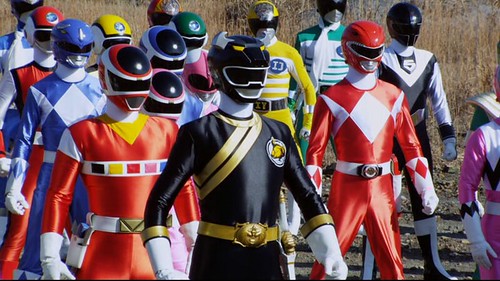


Granted, none of the original actors are in those costumes, but plenty of them showed up for cameos, including Kenji Ohba, seen here with two other sentai veterans whom I don’t recognize.

Many others showed up to speak to the new protagonists through some kind of spiritual dimension.





(Now, I wonder if in 2033 we’ll see a 40-year reunion of Jason David Frank, Amy Jo Johnson and others from the original Mighty Morphin cast.)
The franchise continues to go on, with this year’s season, “Shuriken Sentai Ninninger,” which is on the air in Japan right now, adopting a ninja theme.
Meanwhile, on Nickelodeon every Saturday at 12:00 PM (EST), “Power Rangers Dino Charge” continues the adventures of the American counterpart, although all filmed in New Zealand now. This season is based on the 2013 sentai season, “Zyuden Sentai Kyoryuger.”
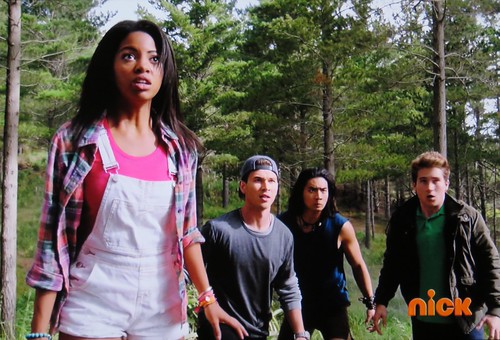
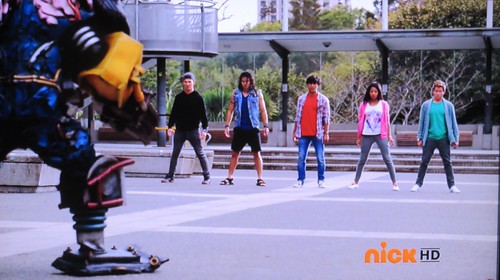

I must say that the cast members of “Dino Charge” are quite an endearing bunch. The acting is very good and the characters quite admirable in all respects. It’s a delight to spend 30 minutes with them every Saturday.
Getting back to Zyuranger’s transformation into Mighty Morphin Power Rangers, Erik Davis writing in the Village Voice (“Half Japanese: Power Rangers Corrupt? Absolutely!” Village Voice, June 21, 1994) had this to say:
The rough transition and lack of continuity between the Japanese and American footage is a sign not only of Saban’s bargain-basement editing but of the dreamlike and monstrous scrambling of cultural codes. Our Wonder Bread heroes are not just turning Japanese, they’re becoming altered beings in a parallel aesthetic realm, with its own internal logic, myths, and ethics. And maybe their audience is somehow transforming too….
“...The tykes currently addicted to the show may end up becoming a mass market for more mature and vital Japanese popular arts now shrouded in hipster subculture–e.g. anime (Japanese animation) and manga (Japanese comic books).
How right Davis was.
Finally, I can announce with some joy that the original Zyuranger series has come out in the U.S. from Shout Factory complete with English subtitles. So I can finally watch those episodes first experienced 22 years ago and now know what the heck is going on.
Now, how could I be denied a reference like that?
ADDENDUM (9/6/16): In March of this year, I visited Toei Kyoto Studio Park in Kyoto, Japan and delighted in the extensive sentai gallery in the park’s museum. I covered my trip there in Japan Journal, Part 6: Toei Kyoto Studio Park.
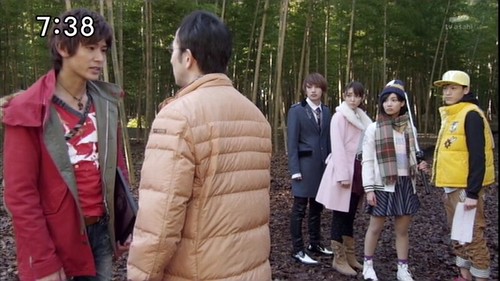









Leave a comment